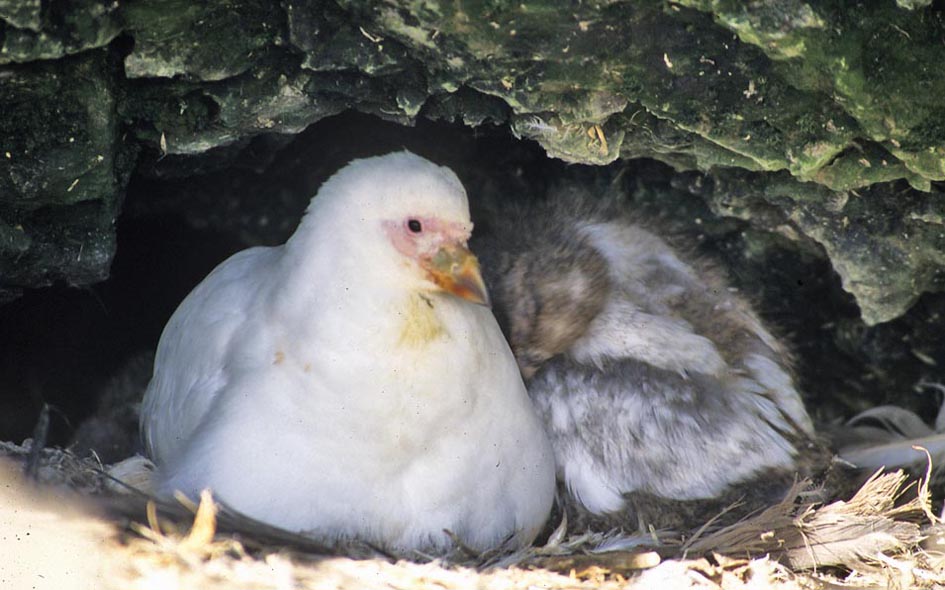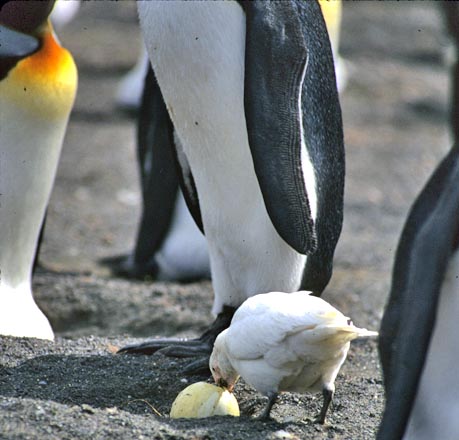
a web page by Don Roberson |
SHEATHBILLS Chionidae |
|
Most observers see Snowy Sheathbill (left, in a nice shot by Lois Goldfrank). It breeds on the Antarctic Peninsula and nearby subantarctic islands After breeding, much of the population migrates north to the Falkland Is. and to Tierra del Fuego and Patagonia, where it also frequents colonies of seabirds, mostly penguins.
|
The other species, much less often seen, is Black-faced Sheathbill Chionis minor. It is more sedentary than Snowy Sheathbill, and generally remains around its breeding islands in the subantarctic Indian Ocean: Crozet, Kerguelen, Mion and Prince Edward, and the McDonalds and Heard I. Its bill, bill sheath and facial caruncles are black (not pink as in Snowy) but its leg color varies among island subspecies. |
 |
| Snowy Sheathbill breeds in a cup nest of debris within a rock cavity (above, photo of adult and chick on the Antarctic Peninsula by Greg W. Lasley). Pairs are monogamous. They arrive on strongly-held territories in the southern 'spring' (Oct-Nov), hatch young in Jan-Feb, and fledge young by March. The chick, as you can see, has mottled gray down among the white feathers. Most Sheathbills leave the breeding areas by April-May, but sometimes can be as late as July (Berger 1996). |
While sheathbills at Cape Town seem likely vagrants, the occasional bird much farther north (e.g., Europe) are traditionally treated as 'ship-assisted' and 'uncountable' by birders. It does seem improbable that a genuinely wild sheathbill would turn up in Europe, but there remains a wide variation in opinion on whether the use of ships by migratory birds and/or seabirds somehow affects that status as wild vagrants within a more expected sphere of migratory flight. Having spent 4 months at sea, and noting the many birds that landed aboard our research vessel, I generally consider ships to be a 'normal' part of the life of pelagic and migratory species. Before humans and ships, birds landed on ice-bergs, kelp patches, sea turtles (alive and dead), and sorts of flotsam far out at sea. Rails and other 'sedentary' birds colonized islands in the central Pacific and evolved into new species, and evolved flightlessness, all with the aid of human. That boobies or sheathbills might routinely land on ships at sea and ride for a time is neither extraordinary or unusual. We had a Red-footed Booby that roosted on our research ship at night, foraged around it during the day (eating flying-fish), and then left us as we neared Hawaii. It acted exactly as any wild bird would act, indiscriminately using our ship or a floating log or a floating dead turtle (I've seen Red-foots sitting on all of these) when not foraging. Sheathbills evolved from plover-like birds in the subantarctic tip of South America, and surely co-evolved with penguin colonies. Their nearest extant relative is Magellanic Plover Pluvianellus socialis of southern South America (Paton et al. 2003, Baker et al. 2007, Fain & Houde 2007). Since the early 21st century, most world checklists list Magellanic Plover and Sheathbills next to each other, but each in a separate family. Cracraft (2013) reduced Magellanic Plover to a subfamily of the Chionidae but this approach was not accepted by the South American Classification Committee nor by other global checklists. |
Photos: Lois Goldfrank photographed the uppermost Snowy Sheathbill Chionis albus
after it landed on her boat when near Paulet I., near the Antarctic
Peninsula, on January 19, 2010. Greg W. Lasley photographed the Snowy Sheathbill
with a King Penguin egg on S. Georgia I. on 26 Jan 1998, and he
photographed nesting adult with chick at Hannah Pt., Antarctic
Peninsula, on 31 Jan 1998. Our vagrant was in the Cape Town harbor on 2
July 2005. Bibliographic note: There is no "family book" for this small family, but the entire set is well-covered in the Handbook of the Birds of the World series (Burger 1996). Literature cited:
|
 Sheathbills
are very strange scavengers from the bottom of the globe. There are
just two species, and they are the only bird family with a breeding
range entirely within the Antarctic and subantarctic islands. They are
scavengers and occasional predators at penguin and seal colonies in
this harsh environment. Although "in no way adapted to an aquatic
lifestyle, they form the only terrestrial bird family in an environment
teeming with seabirds" (Burger 1996). They are adapted to the cold with
a thick layer of under-down.
Sheathbills
are very strange scavengers from the bottom of the globe. There are
just two species, and they are the only bird family with a breeding
range entirely within the Antarctic and subantarctic islands. They are
scavengers and occasional predators at penguin and seal colonies in
this harsh environment. Although "in no way adapted to an aquatic
lifestyle, they form the only terrestrial bird family in an environment
teeming with seabirds" (Burger 1996). They are adapted to the cold with
a thick layer of under-down. Both
sheathbills have entirely white plumage. That plumage is often stained
with blood or offal from its diet of carrion and placenta; feces of
birds and seals; krill, fish, or squid stolen from penguins; and
intertidal algae and invertebrates. In places where it spends the
non-breeding season with humans, it also eats garbage (Burger 1996).
This Snowy Sheathbill (right, in a photo by Greg W. Lasley) is eating the contents of a broken egg in a King Penguin colony
Both
sheathbills have entirely white plumage. That plumage is often stained
with blood or offal from its diet of carrion and placenta; feces of
birds and seals; krill, fish, or squid stolen from penguins; and
intertidal algae and invertebrates. In places where it spends the
non-breeding season with humans, it also eats garbage (Burger 1996).
This Snowy Sheathbill (right, in a photo by Greg W. Lasley) is eating the contents of a broken egg in a King Penguin colony  The
northward migration spins an entire population of Snowy Sheathbills
northward in the non-breeding season, many of which reach coastal South
America, and particularly the Atlantic coast as far north as Uruguay
and southern Brazil. During migration they've been observed resting on
icebergs and, sometimes, they land on ships. Vagrants have reached Cape
Town, South Africa, in some regularity, suggesting these are entirely
wild and unrestrained birds. They fly well and can be quite timid, like
the two that Rita and I twitched at the Cape Town waterfront in July
2005, with a passel of local birders. The two birds flew swiftly
between docks and jetties in the port, and one quickly left us behind.
Through stealth, we finally got this shot (right) of remaining one —
but it was in flight towards a distant jetty shortly thereafter.
The
northward migration spins an entire population of Snowy Sheathbills
northward in the non-breeding season, many of which reach coastal South
America, and particularly the Atlantic coast as far north as Uruguay
and southern Brazil. During migration they've been observed resting on
icebergs and, sometimes, they land on ships. Vagrants have reached Cape
Town, South Africa, in some regularity, suggesting these are entirely
wild and unrestrained birds. They fly well and can be quite timid, like
the two that Rita and I twitched at the Cape Town waterfront in July
2005, with a passel of local birders. The two birds flew swiftly
between docks and jetties in the port, and one quickly left us behind.
Through stealth, we finally got this shot (right) of remaining one —
but it was in flight towards a distant jetty shortly thereafter.